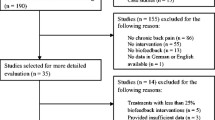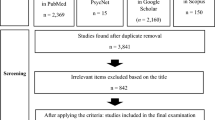Abstract
Previous studies reported that respiratory feedback (RFB) aids in alleviating chronic pain. However, to date, this adjunct treatment has not been rigorously tested against non-contingent (placebo) feedback. Forty-two patients with chronic low back pain were randomized to either RFB or non-contingent RFB. Both groups performed a daily 30-min home training for 15 consecutive days. A respiratory associated relaxation index (RI) was measured. Pain levels and a somatosensory profile were assessed before and after intervention. Additionally, pain levels were assessed 3 months after the end of intervention. Secondary outcome parameters included daily functioning, psychopathology, and suggestibility. T-tests showed higher and significant pain reductions for RFB, compared to non-contingent RFB. Between-group comparisons reached no significance. However, changes were more pronounced in the RFB condition, which was also true for the course of the RI and the psychopathological scores. This is the first study using a non-contingent respiratory placebo feedback in a randomized, controlled design. Within this design previous positive findings of symptom reductions in patients treated with RFB could partially replicated. Nonetheless, tendencies suggest that contingent feedback patients compared to placebo patients profit more from RFB in the long run regarding reduction of chronic pain and psychological distress.

Similar content being viewed by others
References
Andrasik, F., Flor, H., & Turk, D. C. (2005). An expanded view of psychological aspects in head pain: The biopsychosocial model. Neurological Science, 26, S87–S91.
Armagan, O., Tascioglu, F., & Oner, C. (2003). Electromyographic biofeedback in the treatment of the hemiplegic hand: A placebo-controlled study. American Journal of Physical Medicine and Rehabilitation, 82, 856–861.
Barolin, G. S. (2001). Das respiratorische Feedback (RFB)—Basis und Praxis [The respiratory feedback (RFB)—Basics and practice]. In G. S. Barolin (Ed.), Das Respiratorische Feedback nach Leuner [Leuner’s respiratory feedback] (pp. 9–31). Berlin: Verlag für Wissenschaft und Bildung.
Bender, R., Lange, S., & Ziegler, A. (2002). Multiples Testen–Artikel Nr. 12 der Statistik-Serie in der DMW. Deutsche Medizinische Wochenschrift, 127, T4–T7.
Buse, D. C., & Andrasik, F. (2009). Behavioral medicine for migraine. Neurologic Clinics, 27, 445–465.
Cohen, J., & Sedlack, K. (1983). Attention and autonomic self-regulation. Psychosomatic Medicine, 45, 243–257.
Degen, R. (2004). Lexikon der Psycho-Irrtümer: Warum der Mensch sich nicht therapieren, erziehen und beeinflussen lässt. 2. Aufl. [Dictionary of mistakes in psychology: Why people cannot be treated, educated and influenced] (pp. 299–311). München: Piper.
Del Pozo, J., Gevirtz, R. N., Scher, B., & Guarneri, E. (2004). Biofeedback treatment increases heart rate variability in patients with known coronary artery disease. American Heart Journal, 147, e11.
Derogatis, L. R. (1986). SCL-90-R. Self report symptom inventory. In C. I. P. Scalarum (Ed.), Internationale Skalen für Psychiatrie. Weinheim: Beltz Test GmbH.
Dusek, J. A., Otu, H. H., Wohlhueter, A. L., Bhasin, M., Zerbini, L. F., Joseph, M. G., et al. (2008). Genomic counter-stress changes induced by the relaxation response. PloS One, 3, e2576. doi:10.1371/journal.pone.0002576.
Eisenberg, E., McNicol, E., & Carr, D. B. (2006). Opioids for neuropathic pain. Cochrane database of systematic reviews, issue 3, Art. No.: CD006146. DOI: 10.1002/14651858.CD006146.
Engel, K. (1995). Meditation–Geschichte, Systematik, Forschung, Theorie [Meditation–History, classification, research, theory]. Frankfurt: Peter Lang.
Flor, H. (2003). Cortical reorganisation and chronic pain: Implications for rehabilitation. Journal of rehabilitation medicine: Official Journal of the UEMS European Board of Physical and Rehabilitation Medicine, 41(Suppl.), 66–72.
Flor, H., & Diers, M. (2007). Limitations of pharmacotherapy: Behavioral approaches to chronic pain. Handbook of Experimental Pharmacology, 177, 415–427.
Franck, M., Schäfer, H., Stiels, W., Wassermann, R., & Herrmann, J. M. (1994). Entspannungstherapie mit dem respiratorischen Feedback bei Patienten mit essentieller Hypertonie [Relaxation therapy with respiratory feedback in patients with essential hypertonus]. Psychotherapie, Psychosomatik, Medizinische Psychologie, 44, 316–322.
Franke, G. (1992). Eine weitere Überprüfung der Symptom-Check-Liste (SCL-90-R) als Forschungsinstrument. Diagnostica, 38, 160–167.
Franke, G. (1995). Die Symptom-Checkliste von Derogatis–Deutsche Version–(SCL-90-R). Manual [The Symptom Check List–German version–(SCL-90-R). Manual]. Göttingen: Beltz Test GmbH.
Franke, G. (2000). The Symptom Check-List-90-R (SCL-90-asR): A German validation study. Quality of Life Research, 9, 185–193.
Gevirtz, R. (2000). Resonant frequency training to restore homeostasis for treatment of psychophysiological disorders. Biofeedback, 27, 7–9.
Gevirtz, R. (2003). The promise of HRV biofeedback: Some preliminary results and speculations. Biofeedback, 31, 18–19.
Gevirtz, R. (2006). The muscle spindle trigger point model of chronic pain. Biofeedback, 34, 53–56.
Glisky, M. L., Tataryn, D. J., Tobias, B. A., Kihlstrom, J. F., & McConkey, K. M. (1991). Absorption, openness to experience, and hypnotizability. Journal of Personality and Social Psychology, 60, 263–272.
Goleman, D. (1995). Emotional intelligence. New York: Bantam.
Greenberg, J. S. (2004). Comprehensive stress management. MA: McGraw-Hill College.
Hardt, J., Gerbershagen, H. U., & Franke, P. (2000). The symptom check-list, SCL-90-R: Its use and characteristics in chronic pain patients. European Journal of Pain, 4, 137–148.
Hautzinger, M., & Bailer, M. (1993). ADS—Allgemeine depressions Skala. Bern: Huber.
Heywood, C., & Beale, I. (2003). EEG biofeedback vs. placebo treatment for attention-deficit/hyperactivity disorder: A pilot study. Journal of Attention Disorders, 7, 43–55.
Hoffman, B. M., Papas, R. K., Chatkoff, D. K., & Kerns, R. D. (2007). Meta-analysis of psychological interventions for chronic low back pain. Health Psychology, 26, 1–9.
Hubbard, D. R., & Berkoff, G. M. (1993). Myofascial trigger points show spontaneous needle EMG activity. Spine, 18, 1803–1807.
Hunyor, S. N., Henderson, R. J., Lal, S. K. L., Carter, N. L., Kobler, H., & Jones, M. (1997). Placebo-controlled biofeedback blood pressure effect in hypertensive humans. Hypertension, 29, 1225–1231.
Jensen, T. S., & Baron, R. (2003). Translation of symptoms and signs into mechanisms in neuropathic pain. Pain, 102, 1–8.
Jung, F., & Klapsing-Hessenbruch, A. (1978). Eine vergleichende Studie der therapeutischen Ergebnisse zwischen Respiratorischem Feedback (RFB) und einer Placebo-Behandlung [A comparison study of therapeutic results between respiratory feedback (RFB) and placebo treatment]. Zeitschrift für Psychosomatische Medizin und Psychoanalyse, 24, 36–55.
Kabat-Zinn, J. (1990). Full catastrophe living. New York: Delta.
Kanbara, K., Mitani, Y., Fukunaga, M., Ishino, S., Takebayashi, N., & Nakai, Y. (2004). Paradoxical results of psychophysiological stress profile in functional somatic syndrome: Correlation between subjective tension score and objective stress response. Applied Psychophysiology and Biofeedback, 29, 255–268.
Karst, M. (2007). Comments on “cannabimimetic properties of ajulemic acid”. The Journal of Pharmacology and Experimental Therapeutics, 322, 420–421.
Kleiger, R. E., Miller, J. P., Jr., & Moss, A. J. (1987). Decreased heart rate variability and its association with increased mortality after acute myocardial infarction. American Journal of Cardiology, 59, 256–262.
Klossika, I., Flor, H., Kamping, S., Bleichhardt, G., Trautmann, N., Treede, R.-D., et al. (2006). Emotional modulation of pain: A Clinical perspective. Pain, 124, 264–268.
Kröner-Herwig, B. (2009). Chronic pain syndromes and their treatment by psychological interventions. Current Opinion in Psychiatry, 22, 200–204.
Laux, L., Glanzmann, P., Schaffner, P., & Spielberger, C. D. (1981). STAI-Das State-Trait-Angst-Inventar. Theoretische Grundlagen und Handlungsanweisung. Weinheim: Beltz Test GmbH.
Lee, K. H., Hill, E., Johnston, R., & Smiehorowski, T. (1976). Myofeedback for muscle retraining in hemiplegic patients. Archives of Physical Medicine and Rehabilitation, 57, 588–591.
Lehrer, P. M., Vaschillo, E., Lu, S.-E., Vaschillo, B., Scardella, A., & Habib, R. H. (2006). Heart rate variability biofeedback. Chest, 129, 278–284. doi:10.1378/chest.129.2.278.
Leuner, H. (2001). Manuskriptfragmente [Manuscript fragments]. In G. S. Barolin (Ed.), Das Respiratorische Feedback nach Leuner [Leuner’s respiratory feedback] (pp. 39–106). Berlin: Verlag für Wissenschaft und Bildung.
Lichtenberg, P., Bachner-Melman, R., Ebstein, R. P., & Crawford, H. J. (2004). Hypnotic susceptibility: Multidimensional relationships with Cloninger’s tridimensional personality questionnaire, COMT polymorphisms, absorption, and attentional characteristics. The International Journal of Clinical and Experimental Hypnosis, 52, 47–72.
Locklin, J. K., Yanof, J., Luk, A., Varro, Z., Patriciu, A., & Wood, B. J. (2007). Respiratory biofeedback during CT-guided procedures. Journal of Vascular and Interventional Radiology, 18, 749–755.
Mader, F. H. (1986). Respiratorisches feedback versus autogenes training [Respiratory feedback versus autogenic training]. Der Allgemeinarzt, 8, 568–574.
McGrady, A. V., Andrasik, F., Davies, T., Striefel, S., Wickramasekera, I., Baskin, S. M., et al. (1999). Psychological therapy for chronic headache in primary care. Primary Care Companion to the Journal of Clinical Psychiatry, 1, 96–102.
Mehling, W. E., Hamel, K. A., Acree, M., Byl, N., & Hecht, F. M. (2005). Randomized controlled trial of breath therapy for patients with chronic low back pain. Alternative Therapies in Health and Medicine, 11, 44–52.
Meuret, A. E., Wilhelm, F. H., & Roth, W. T. (2004). Respiratory feedback for treating panic disorder. Journal of Clinical Psychology, 60, 197–207.
Moss, D. (2004). Heart rate variability (HRV) biofeedback. Psychophysiology Today: The Magazine for Mind-Body Medicine, 1, 4–11.
Nash, J. M., McCroy, D., Nicholson, R. A., & Andrasik, F. (2005). Efficacy and effectiveness approaches in behavioral treatment trials. Headache, 45, 507–512.
Nestoriuc, Y., Martin, A., Rief, W., & Andrasik, F. (2008). Biofeedback treatment for headache disorders: A comprehensive efficacy review. Applied Psychophysiology and Biofeedback, 33, 125–140.
Nouwen, A., & Solinger, J. W. (1979). The effectiveness of EMG biofeedback training in low back pain. Biofeedback and Self-regulation, 4, 103–111.
Ornish, D. (1996). Dr. Dean Ornish’s program for reversing heart disease: The only system scientifically proven to reverse heart disease without drugs or surgery. New York: Ballantine Books.
Pastor, M. C., Menéndez, F. J., Sanz, M. T., & Abad, E. V. (2008). The influence of respiration on biofeedback techniques. Applied Psychophysiology and Biofeedback, 33, 49–54.
Radloff, L. S. (1977). The CES-D Scale: A self-report depression scale for research in general population. Applied Psychological Measurement, 3, 385–401.
Reiner, R. (2008). Integrating a portable biofeedback device into clinical practice for patients with anxiety disorders: Results of a pilot study. Applied Psychophysiology and Biofeedback, 33, 55–61.
Rolke, R., Andrews, C. K., Magerl, W., Birklein, F., & Treede, R. D. (2006a). Quantitative sensory testing: A comprehensive protocol for clinical trials. European Journal of Pain, 10, 77–88.
Rolke, R., Baron, R., Maier, C., Tölle, T. R., Treede, R. D., Beyer, A., et al. (2006b). Quantitative sensory testing in the German research network on neuropathic pain (DFNS): Standardized protocol and reference values. Pain, 123, 231–243. Erratum in: Pain, 125, 197.
Shapiro, D. H. (1980). A scientific/personal exploration—Meditation: Self-regulation strategy and altered state of consciousness. New York: Aldine Publishing Company.
Spielberger, C. D., Gorsuch, R. L., & Lushene, R. E. (1970). Manual for the state-trait-anxiety inventory. Palo Alto: Consulting Psychology Press.
Tait, R. C., Chibnall, J. T., & Krause, S. (1990). The pain disability index: Psychometric properties. Pain, 40, 171–182.
Tait, R. C., Pollard, C. A., Margolis, R. B., Ducro, P. N., & Krause, S. J. (1987). The pain disability index: Psychometric and validity data. Archives of Physical Medicine and Rehabilitation, 68, 438–441.
Tellegen, A. (1982). Brief manual for the multidimensional personality questionnaire. Unpublished manuscript, University of Minnesota, Minneapolis.
Tellegen, A., & Atkinson, G. (1974). Openness to absorbing and self-altering experiences (“absorption”), a trait related to hypnotic susceptibility. Journal of Abnormal Psychology, 83, 268–277.
Turk, D. C., & Flor, H. (1984). Etiological theories and treatments for chronic back pain. II. Psychological models and interventions. Pain, 19, 209–233.
U. S. patent no. 4 665 926. (1987). Retrieved from the Web February 19, 2010. http://patft.uspto.gov/netahtml/PTO/srchnum.htm.
van den Wittenboer, G., van der Wolf, K., & van Dixhoorn, J. (2003). Respiratory variability and psychological well-being in schoolchildren. Behavior Modification, 27, 653–680. doi:10.1177/0145445503256320.
Wickramasekera, I. (1999). How does biofeedback reduce clinical symptoms and do memories and beliefs have biological consequences? Toward a model of mind-body healing. Applied Psychophysiology and Biofeedback, 24, 91–95.
Acknowledgments
We gratefully thank Guenther Stielau and Marlies Machui-Brock, both Biomental Gesellschaft für Mentalsysteme mbH, and Tobias Moeller (MS) and Gabriele Huwald (RN), both Pain Clinic at Hannover Medical School, for their technical support and all patients for their participation in this study. Also, we thank Ludwig Hoy, Ph.D. (Department of Biometrics, Hannover Medical School) for his support in the statistical part of the study.
Author information
Authors and Affiliations
Corresponding author
Rights and permissions
About this article
Cite this article
Kapitza, K.P., Passie, T., Bernateck, M. et al. First Non-Contingent Respiratory Biofeedback Placebo versus Contingent Biofeedback in Patients with Chronic Low Back Pain: A Randomized, Controlled, Double-Blind Trial. Appl Psychophysiol Biofeedback 35, 207–217 (2010). https://doi.org/10.1007/s10484-010-9130-1
Published:
Issue Date:
DOI: https://doi.org/10.1007/s10484-010-9130-1




